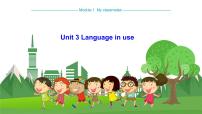










外研版 (新标准)七年级上册Unit 3 Language in use.课文ppt课件
展开Module 7 Computers
Unit 3 Language in use
设计说明 本单元是复习单元,主要复习含有行为动词的一般现在时的特殊疑问句,运用所学知识训练一般现在时的特殊疑问句句式的提问和回答。通过学习计算机的发展史,让学生了解世界其他地方的人们使用电脑的情况。把学习英语和熟悉电脑的基本应用结合起来,激发学生对英语的学习兴趣。 教学目标 通过本单元的教学,让学生达成以下目标: 1. 知识目标 复习巩固本模块所学的生词和短语。 2. 能力目标 (1) 能结合本模块所学的语言知识,准确运用所学句型结构作出表达; (2) 能运用一般现在时特殊疑问形式进行问答。 3. 情感目标 学生通过学习电脑相关的英语词汇、句式,培养对英语的学习兴趣。 重点难点 重点:一般现在时的特殊疑问句形式。 难点:熟练运用本模块中所学的词汇和句型,注意助动词do和 does的区别和用法。 教学准备 PPT课件 授课时数 1课时 教学过程 Step 1 Warming up Revision: T: Good morning, boys and girls. Today let’s come to Unit 3. First, think about: How do you do your homework on the computer? / What can we use a computer for? Ss: … T: Show the pictures to review. T: Discuss the question in pairs. What do you do on the Internet? Step 2 Presentation 1. Ask the students to read the sentences in Language practice. How do I write my homework on the computer? What do I do next? Where do I write the name? 2. Let students look at the screen to remember what they have learned. Step 3 Grammar 一般现在时的特殊疑问句 1. 特殊疑问句的含义和疑问词 以疑问词开头,对句中某一成分提问的句子叫特殊疑问句。疑问词包括疑问代词 (what, who, which, whose等) 和疑问副词 (when, where, why, how等) 。 (1) what意为“什么”,主要用来指物。 —What’s this in English? 这个用英语说是什么? —It’s a desk. 这是一张书桌。 what还可以和grade, class, row, team, colour等其他名词连用。 —What grade are you in? 你在几年级? —I’m in Grade One. 我在一年级。 (2) who意为“谁”,主要用来指人,询问人的身份或与说话人的关系。 —Who’s that? 那是谁? —That’s my teacher. 那是我的老师。 (3) where意为“在哪里”,主要用来指地点。 —Where is my pen? 我的钢笔在哪里? —It’s here. 它在这儿。 (4) how意为“如何”“怎样 ”,主要用来表示程度。还可以和其他形容词或副词连用。 —How are you? 你好吗? —I’m fine. 我很好。 (5) whose意为“谁的”,用来询问物品的主人。 —Whose computer is this? 这是谁的电脑? —It’s mine. 这是我的。 (6) when 意为“什么时候”,主要用来询问时间。 When do you write your homework? 你什么时候写家庭作业? 2. 特殊疑问句的语序 (1) 特殊疑问句以疑问词开头,其语序一般是:疑问词+一般疑问句? Where does he live? 他住在哪里? When do they play games? 他们什么时候玩游戏? (2) 如果疑问词在句中作主语或主语的定语,其语序是:疑问词 (+主语) +陈述句? Who teaches you English? 谁教你们英语? Whose pen is this? 这是谁的钢笔? 3. 特殊疑问句的回答 特殊疑问句不能用yes或no的形式来回答,要根据所询问的内容直接作出回答。 —What class are you in? 你在哪个班? —I am in Class four, Grade one. 我在一年级四班。
Step 4 Practice 1. Ask the students to read the questions and answers in Activity 1. ①Have the students match the questions with the answers with partners. ②Call back the answers from the whole class and then check the answers. Answers:1—b);2—c);3—d);4—a) 2. Ask the students to read through the example conversation in Activity 2. ①Have them complete the conversations in Activity 2 with their partners. ②Call back the answers from the whole class and then check the answers. Answers:1 How do I 2 What does he do 3 When does she use 4 Who do you write 5 How many emails do they send/What do they send 3 Let the students read the conversations aloud. Read through the sentences in Activity 3 with the whole class. ①Ask the students to complete the sentences with the correct form of the words in brackets. ②Call back the answers from the whole class and then check the answers. Answers: 1 doesn’t see, sends 2 use, don’t play 3 doesn’t use, play 4 makes, doesn’t buy 5 don’t have, use 4. Ask students to complete the sentences with the correct form of the words from the box. Call back the answers from the whole class,and check the answers. Answers:1 checks 2 use 3 plan 4 like 5 talk Step 5 Reading Around the world 1. Ask the students to read this passage. Before reading,teach the key words and phrases. 2. Then ask a few students to read it,and translate it into Chinese at last. 3. Solve the problems which the students met in reading. 4. Read the passage together. Step 6 Module task:Making a survey about computers 1. Work in groups of three. Write questions about students and computers.
2. Check with your partners. 3. Work with the whole class. Ask and answer questions in Activity 5,and make notes. 4. Work in your group. Make a survey about students and computers. Use the notes you made in Activity 6 to help you. Seven students have a computer at home. Five students use a computer for their homework… Step 7 Homework 1. Review the useful words and expressions. 2. Finish the survey about students and computers. 当堂达标 Ⅰ. 根据句意及汉语提示写出单词。 1. We often get some new (信息) on the Internet. 2. On Sundays I usually (发送) emails to my friends. 3. I have to (分享) a room with my sister. 4. The old man has got two big (公司) in Beijing. 5. He usually (观看) movies or TV plays on Friday evening. Ⅱ. 单项填空。 1. Now more and more students use the computer ________ their homework. A. do B. does C. to do D. doing 2. You can buy almost everything ________ the Internet, and it’s very easy. A. into B. for C. at D. on 3. ________computers are there in your school computer room? A. How large B. How much C. How often D. How many 4. The girl plans ________ the Great Wall. A. visit B. visiting C. to visit D. visits 5. Lingling ________ a study plan every Friday. A. makes B. does C. washes D. catches Ⅲ. 根据汉语意思完成句子。 1. 你通常在电脑上做什么? ________ ________ you usually ________on the computer? 2. 你经常给你的朋友写信吗? Do you often ________ ________ your friends? 3. 我每天查看我的电子邮件。 I ________ ________ ________ every day. 4. 他在2010年出生于美国。 He ________ ________ ________ America in 2010. 5. 他是他弟弟年龄的一倍半。 He is________ ________ ________ ________ ________ as old as his brother. 答案:I. 1. information 2. send 3. share 4. companies 5. watches II. 1-5 CDDCA Ⅲ. 1. What do, do 2. write to 3. check my email 4. was born in 5. one and a half times
板书设计
| 教学反思
| ||||||||||||||||||||||||||||
初中英语外研版 (新标准)七年级上册Unit 3 Language in use.示范课ppt课件: 这是一份初中英语外研版 (新标准)七年级上册Unit 3 Language in use.示范课ppt课件,文件包含Module9Unit3pptx、外语教研版中学英语七年级上Module9Unit3教学详案docx等2份课件配套教学资源,其中PPT共19页, 欢迎下载使用。
英语七年级上册Unit 2 When do you use a computer?教学课件ppt: 这是一份英语七年级上册Unit 2 When do you use a computer?教学课件ppt,文件包含Module7Unit2pptx、外语教研版中学英语七年级上Module7Unit2教学详案docx等2份课件配套教学资源,其中PPT共29页, 欢迎下载使用。
初中英语外研版 (新标准)七年级上册Unit 1 How do I write my homework on the computer?课文配套ppt课件: 这是一份初中英语外研版 (新标准)七年级上册Unit 1 How do I write my homework on the computer?课文配套ppt课件,文件包含Module7Unit1pptx、外语教研版中学英语七年级上Module7Unit1教学详案docx等2份课件配套教学资源,其中PPT共24页, 欢迎下载使用。














